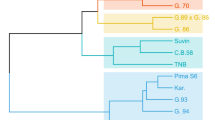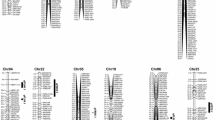Abstract
American Pima cotton (Gossypium barbadense L.) is grown in the southwest United States, and no Pima cotton hybrid is commercially grown. In this study, six commercial Pima cultivars (Pima S-7, Pima S-6, Phy 76, BR 007, DP 340, and DP 744) and three elite germplasm lines (SI 1331, 93252, and 8810) were crossed in a diallel mating scheme without reciprocals, and their 36 F2 and F3 progeny were planted in replicated tests at two locations (L) in 2004–2005. Yield and fiber traits were analyzed using Griffing’s Model 1, Method 2 diallel analysis. Genetic distance (GD) of parent lines was determined using 661 AFLP molecular markers. Across locations, significant genotype (G) and general combining ability (GCA) effects were detected for yield, boll size, lint percent, micronaire, 2.5% fiber length, fiber strength, and elongation. Significant specific combining ability (SCA) effects were detected for yield, micronaire, and strength. Lint yield and the yield components- boll size and lint percent exhibited significant G × L interactions. Significant GCA × L interactions occurred for yield and lint percent. Yield, boll size, and micronaire also had significant SCA × L interactions. No significant GCA or SCA by L interactions were detected for fiber length, strength, and elongation. The mean mid-parent heterosis (MPH) of the 36 hybrids in lint yield was low in F2, but non-existent in F3. Among the nine parents, Pima S-7 and DP 340 had the highest and significant positive GCA effects for lint yield, lint percent, and boll weight across tests. Only several F2 hybrids with Pima S-7 and DP 340 as one parent displayed some levels of useful heterosis in lint yield in the two locations, as compared to Pima S-7 as the check. MPH for other agronomic and fiber quality traits was low to non-existent in both generations. The average GD of the parents were not significantly correlated with their GCA effects, and GD between parents was also not correlated with SCA and MPH of their hybrids, with the exception of lint yield at the Las Cruces location where a significant negative correlation was obtained. However, GD of the parents was correlated with the performance of hybrids in lint yield, fiber length, fiber strength and elongation in one or two tests. This study represented one of the first studies to estimate heterosis, combining ability, and their relationship with genetic distance of parents in a representative subset of Pima cotton genotypes.
Similar content being viewed by others
References
Abdalla AMA, Abou-El-Zahab AA, Radwan SRH (1999) Combining ability for yield and earliness of Pima × Egyptian cotton cultivars crosses. In: Proceedings beltwide cotton conferences, Orlando, Florida, USA, 3–7 Jan 1999. 1: pp 473-477
Abo El-Zahab AA, Metwaly HN (1979) Heterosis and combining ability in Egyptian cotton, Gossypium barbadense L. Zeitschrift fur Pflanzenzuchtung 82:45–69
Campbell BT, Bowman DT, Weaver DB (2008) Heterotic effects in topcrosses of modern and obsolete cotton cultivars. Crop Sci 48:593–600
Davis DD (1978) Hybrid cotton: specific problems and potentials. Adv Agron 30:129–157
Dong H, Tang W, Zhang D (2004) Development of hybrid Bt cotton in China: a successful integration of transgenic technology and conventional techniques. Curr Sci 86:778–782
Feaster CV, Turcotte EL (1984) Registration of Pima S-6. Crop Sci 24:382
Griffing B (1956) Concept of general and specific combining ability in relation to diallel crossing systems. Aust J Biol Sci 9:463–493
Gutiérrez OA, Basu S, Saha S, Jenkins JN, Shoemaker DB, Cheatham CL, McCarty JC (2002) Genetic distance among selected cotton genotypes and its relationship with F2 performance. Crop Sci 42:1841–1847
Hamoud HME (2014) Use of biplot approach for genetic analysis of yield and related traits in cotton (Gossypium barbadense). J Plant Breed Crop Sci 6:41–47
Huang X, Yang S, Gong J, Zhao Q, Feng Q, Zhan Q, Zhao Y, Li W, Cheng B, Xia J, Chen N, Huang T, Zhang L, Fan D, Chen J, Zhou C, Lu Y, Weng Q, Han B (2016) Genomic architecture of heterosis for yield traits in rice. Nature 537:629–633
SAS Institue (2000) SAS/STAT user’s guide. version & SAS institute, Cary
Mei YJ, Zhang GS, Ye ZH, Guo WF (2005) Genetic analysis on heterosis of lint yield and fiber traits of F1 and F2 hybridization between “0” type and long-fruit-branch plant type in sea island cotton. Sci Agric Sin 38:1106–1112
Meredith WR (1984) Quantitative genetics. In: Kohel RJ, Lewis CF (eds) Cotton. Agron Monog no. 24, ASA-CSSA-SSSA, Madison, pp 131–150
Meredith WR (1990) Yield and fiber-quality potential for second-generation cotton hybrids. Crop Sci 30:1045–1048
Meredith WR, Brown JS (1998) Heterosis and combining ability of cottons originating from different regions of the United States. J Cotton Sci 2:77–84
Percy RG (2002) Registration of five extra-long staple cotton germplasm lines possessing superior fiber length and strength. Crop Sci 42:988
Percy RG (2009) The worldwide gene pool of Gossypium barbadense L. and its improvement. In: Paterson AH (ed) Genetics and genomics of cotton. Springer, New York, pp 53–68
Percy RG, Turcotte CL (1998) Registration of extra-long staple cotton germplasm, 89590 and 8810. Crop Sci 38:1409
Percy RG, Wendel JF (1990) Allozyme evidence for the origin and diversification of Gossypium barbadense L. Theor Appl Genet 79:529–542
Robert CL, Cantrell RG, Ball ST (1997) Release of New Mexico Sea Island 1331. In: Proceedings Beltwide Cotton Conference, New Orleans, LA. 7–10 Jan 1997. National Cotton Council of America, Memphis, TN, p. 473
Rohlf FJ (2005) NTSYS-pc numerical taxonomy and multivariate analysis system, version 2.2. Exeter Software, Setauket, NY
Santhy V, Khadi BM, Singh P, Vijaya Kumari PR, Deshmukh RK, Vishwanathan A (2008) Hybrid seed production in cotton. CICR Tech Bull No 35:1–25
Tang B, Jenkins JN, McCarty JC, Watson CE (1993a) F2 hybrids of host plant germplasm and cotton cultivars: I Heterosis and combining ability for lint yield and yield components. Crop Sci 33:700–705
Tang B, Jenkins JN, McCarty JC, Watson CE (1993b) F2 hybrids of host plant germplasm and cotton cultivars: II. Heterosis and combining ability for fiber properties. Crop Sci 33:706–710
Turcotte EL, Percy RG, Feaster CV (1992) Registration of ‘Pima S-7’ American Pima cotton. Crop Sci 32:1291
Wang XQ, Feng CH, Lin ZX, Zhang XL (2011) Genetic diversity of sea-island cotton (Gossypium barbadense) revealed by mapped SSRs. Genet Mol Res 10:3620–3631
Westengen OT, Huamán Z, Heun M (2005) Genetic diversity and geographic pattern in early South American cotton domestication. Theor Appl Genet 110:392–402
Zeng LH, Meredith WR (2012) Relationship between SSR-based genetic distance and cotton F2 hybrid performance for lint yield and fiber properties. Crop Sci 51:2362–2370
Zhang JF, Stewart JM (2000) Economical and rapid method for extracting cotton genomic DNA. J Cotton Sci 4:193–201
Zhang JF, Lu Y, Yu S (2005a) Cleaved AFLP (cAFLP), a modified amplified fragment length polymorphism analysis for cotton. Theor Appl Genet 111:1385–1395
Zhang Y, Kang MS, Lamkey KR (2005b) DIALLEL-SAS05: a comprehensive program for Griffing’s and Gardner-Eberhart analyses. Agron J 97:1097–1106
Zhang XQ, Wang XD, Jiang PD, Hua SJ, Zhang HP, Dutt Y (2007) Relationship between molecular marker heterozygosity and hybrid performance in intra- and interspecific hybrids of cotton. Plant Breed 126:385–391
Zhang JF, Percy RG, McCarty JC (2014) Introgression genetics and breeding between Upland and Pima cotton- a review. Euphytica 198:1–12
Zhang JF, Wu M, Yu J, Li X, Pei W (2016) Breeding potential of introgression lines developed from interspecific crossing between Upland cotton (Gossypium hirsutum) and Gossypium barbadense: heterosis, combining ability and genetic effects. PLoS ONE 11:e0143646
Zhang JF, Abdelraheem A, Wu JX (2017) Heterosis, combining ability and genetic effect, and relationship with genetic distance based on a diallel of hybrids from five diverse Gossypium barbadense genotypes. Euphytica 213(9):208
Acknowledgements
This study was a joint research project with Dr. Richard G. Percy at U.S. Arid Land Agricultural Research Center, USDA-ARS, Maricopa, AZ, before he moved to Crop Germplasm Research Unit, USDA-ARS, College Station, TX. Dr. Percy performed the field tests in the Maricopa location and contributed to the data and results analysis before his retirement. His contributions are highly appreciated.
Author information
Authors and Affiliations
Corresponding author
Electronic supplementary material
Below is the link to the electronic supplementary material.
Rights and permissions
About this article
Cite this article
Zhang, J.F., Abdelraheem, A. Combining ability, heterosis, and genetic distance among nine elite American Pima cotton genotypes (Gossypium barbadense). Euphytica 213, 240 (2017). https://doi.org/10.1007/s10681-017-2036-8
Received:
Accepted:
Published:
DOI: https://doi.org/10.1007/s10681-017-2036-8




